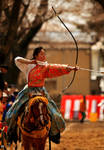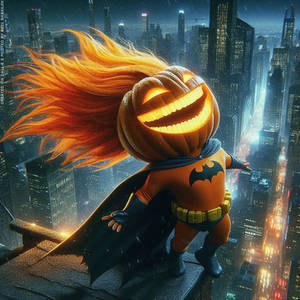With movies like Avengers, Brave and Hunger Games, 2012 seems to be the Year of the Archers and many artists have already been inspired to create their own archer characters.
Whether you're thinking about having one of your OCs pick up bow and arrow (in writing or drawing) or you're a stock artist who wants to create some decent archery stock, I hope this little guide helps you understand the wonderful thing that is archery.
First and foremost, a little disclaimer: For this article I will mainly draw from my own experiences over the past few years. I am what you'd call an intuitive or instinctive archer, which roughly comes closest to medieval-styled archery. At the moment I'm shooting a modern Samick bow (without stabilizer or sights) and am in the process of making my own recurve bow out of robinia wood (similar to a few bows you can see in my gallery).
However, in archery there are many styles and differences in material used, draw, stance, finger position etc. – it all depends on the context of your story/drawing/stock shoot and I can't possibly provide sufficient information here for every aspect of archery. I'd be happy, though, if this little compilation sparked some interest and encourages you to learn more about archery.
I'll try and include a few images to illustrate the text as well as links and videos for further research. And I'd like to thank snappapple and PirateLotus-Stock for the feedback and help in creating this article – and of course all my wonderful models who are featured here as example pics
Let's start with the equipment:
1. Bows
There are many different types of bows, the most common ones in western style archery being longbow and recurve bow. There are both modern versions of these bows (made out of modern materials such as fiberglass) and traditional versions carved out of one piece of wood (creating recurved limbs is rather easy: all you need is boiling water = steam) or made of different materials (so-called composite bows).
Traditional:
Modern:
The advantage of recurved limbs is that they permit the bow to be shorter and thus easier to handle while maintaining the same level of energy and power. A reflex bow is an extreme form of recurve: Rider bows for example need to be shorter so that the rider can turn around on horseback without whacking their faithful steed every time they do.
Another impressive and very distinctive bow is the so-called yumi, used in Japanese archery (=kyudo) as well as horseback archery (=yabusame), you'll usually see the long, asymmetrical version. Japanese archery is often seen as meditative, with a focus on the art of repetition, the perfection of the shot rather than scoring as many points as possible, however it did start out as a weapon of the Samurai and is not to be underestimated.


For contemporary bow hunting most hunters today will use compound bows that feature a system of cables and pulleys. Not only does it store more energy, it also allows for the archer to aim without the pressure of the bow string.

2. Arrows
There are again different types of arrows, plumage and arrowheads. Nowadays most modern arrows are made of carbon or aluminum, but wooden arrows are still in use.
:thumb278855542:
I'm going to tell you how I've learned to fletch my arrows but if you dare take a look into an archery forum you'll soon find that there's almost endless discussion on what's the best way to do it. I use three feathers, they are glued to the wooden shaft and secured with string (see image above).
The cock feather often has a different colour and should be placed in a 90° angle to the nock (= slot to place on the bow string) and when you shoot it points away from the bow (again, that seems to be open for discussion).

A special type of arrow is the so called flu-flu, used for bird and short distance hunting. The big feathers spiral around the wood, which makes the arrow slow down faster and thus easier to find if the archer misses their target.
(They also go "whooooosh!")

As for arrowheads, you'll find that most modern archers use narrow points (field or target points) that are easy to pull from the target and don't cause much damage. However, there are also arrowheads designed to cause as much damage to the victim/prey as possible: broadheads, that feature two or four sharp blades and cause a bigger wound and massive bleeding. Those would be used for hunting and war-related matters.

3. Protection
The basic protection kit nowadays would be an armguard or cuff for your forearm and a finger-glove for the fingers you draw the bow string with.
Technically neither is necessary if you shoot often and correctly, however when using wooden arrows I still recommend the cuff as I've only recently witnessed what a (more or less unnoticeably) damaged wooden arrow can do to you when you try to shoot it and it basically explodes on your bow string.

If you shoot a bow without an arrow rest you could also use a glove for the hand that holds the bow, and there's much more gear to give your archer if you want, such as chest guards or armguards that cover the whole arm that holds the bow.
One thing you should keep in mind: if your archer has long hair it might get caught in the bow string – same goes, of course, for other dangly things like necklaces or ribbons etc. That doesn't mean you have to get rid of everything, but keep it in mind when designing your character.
Here is where it gets interesting for stock artists, and while I can try to describe the posture and show you the images, I know that it's still difficult to get it right when you've never had actual training or instructions. So I hope I can still give you a few pointers to make it easier to get started:
1. Posture
For a good archery posture the most important thing to consider is the following:
The strength comes from the archer's back, not their arms.
In fact, many physical therapists recommend archery as a therapy for back problems. When I started out it helped me to imagine the point between my shoulder blades like a pulley to take my mind off the arm muscles.
Your archer should stand sideways to their target and only rotate their torso, feet slightly apart and relaxed. The way that works best for me is to lean slightly forward with more weight on the foot that's closer to the target.
Both eyes are open, the string is drawn to the face (don't lower their face to meet the string). The movement should be fluid and quick without any overly capricious, show-off extra moves.
2. Arms and Hands
The arm that holds the bow should be straight but not over-stretched from the very beginning with the elbow pointing to the side rather than to the floor, else they will probably end up smacking their forearm (which is something every beginner has to go through).


The arm that holds the string should draw the string straight backwards, with the forearm being in line with the arrow. A very common mistake I see is the elbow being held higher than the arrow line.


The hand that draws the string holds the string, not the arrow. Typically you'd draw with index, middle and ring finger (either all three fingers below the arrow OR index above, middle and ring finger below the arrow) but that varies in different styles. The release should be smooth and relaxed and the hand should stay in place for a few seconds after.
The hand that holds the bow holds the bow, not the arrow. The arrow should never go between the fingers, it will be painful and probably derail the arrow of its target. The grip around the bow is soft and never tense, some archers keep their hands open during the draw and only close it around the bow last second.
Typically a right-hand bow places the arrow left of the bow grip but, again, that varies in different styles (it's different in kyudo, for example, and in horseback archery for faster reloading)
3. Anchor Point
Find a suitable anchor point. The anchor point is a point on an archer's face they always draw the string to. This ensures that the full draw stays consistent – that means when you paint or draw your archer-OC you should always give him the same anchor point.
It doesn't matter whether it's a high anchor point (cheekbone, ear, even corner of the eye) or low anchor point (jaw, chin or under) as long as it's consistent.
For stock-artists this means: Don't be afraid of the string. I often see models drawing the string to a "safe" point in front of their face, not to the side of their cheek or chin. That just won't work.
Btw, in Japanese kyudo things are a bit different again – the arrow is usually drawn to a point behind the ear and the hand is not touching the face at all. It's the same for horseback archery, there you'll often find a floating anchor, often drawn to the collarbone area.
4. Common Mistakes
When I look through dA's archery stock I see a few very common posture mistakes which are then often translated to drawings and paintings. Research is essential for both stockers and artists, and with archery it's probably best to not just look at single pics, but rather go to youtube and watch the whole process.
Pixar's "Brave" shows us three wonderful examples of typical posture problems when they gave them to the competing suitors at the tournament. In contrast, Merida actually does a wonderful job. There's a great article that analyzes the trailer and the overall-archery in this movie, seriously have a look: www.wired.com/geekdad/2012/02/…
I hope this article could give you a little visual guide on how-to and how-not-to
Archery has become an important part of my life and I can only urge you to give it a try, especially now that it has become a bit more mainstream and archery clubs are growing everywhere. Pick up a bow and shoot something!
For further research:
Here's a very nice and compact Beginner's Guide to Archery, including some information on different styles, equipment and what to think of when you want to get into archery and need to buy your set-up: www.merlinarchery.co.uk/merlin…
And this is a wonderful summary on the anchor point, which is something every archer should know:
www.archery-tips.com/archeryle…
There's a page that offers a few traditional books on archery to read online, amongst them "Toxophilus" by Roger Ascham (written in 1545), which is sometimes considered the traditional archer's bible. If you can deal with the 16th century English, have a look at it here: www.archerylibrary.com/books/
And last but not least: Wikipedia's archery section is actually very reliable and very extensive, so that's always a good place to start: en.wikipedia.org/wiki/Archery
Oh, and before I forget, here are a few of dA's reliable archery stock providers (beside myself, of course
CSS by:
